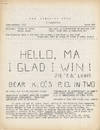![Physics at the British Association in Nature 60, May 1899 to October 1899, pp. 585-587 [FIRST PUBLISHED ANNOUNCEMENT THAT THE ELECTRON IS A SUBATOMIC PARTICLE]](https://d3525k1ryd2155.cloudfront.net/h/349/691/841691349.0.m.jpg)
Physics at the British Association in Nature 60, May 1899 to October 1899, pp. 585-587 [FIRST PUBLISHED ANNOUNCEMENT THAT THE ELECTRON IS A SUBATOMIC PARTICLE]
- Used
- Hardcover
- first
- Condition
- See description
- Seller
-
West Branch, Iowa, United States
Payment Methods Accepted
About This Item
1899. 1st Edition. FIRST PUBLISHED ANNOUNCEMENT THAT THE ELECTRON IS A SUBATOMIC PARTICLE. Mention of J. J. Thomson's report at the 1899 meeting of the British Association for the Advancement in Science in Dover "On the existence of masses smaller than atoms," and published in the October 12 issue of Nature included here is the first published announcement that the electron is a subatomic particle.
Beginning in 1883, J. J. Thomson "had engaged himself in developing an atomic theory of electric discharge through gases" (Wagh, Essentials of Physics, 421). As his work progressed through his various discoveries, however, there was great reluctance to accept the idea of a body having smaller weight than an atom of hydrogen (this because the atom was then thought to be the ultimate, indestructible constituent of matter). It was not until Thomson read the aforementioned paper at the meeting in Dover, that his deeply interested but unconvinced audience began to accept that Thomson's experimental evidence with respect to subatomic mass was overwhelming.
In the paper Thomson read (and these words were quoted for the first time in the presentation of that meeting in this issue of Nature): "The new particle could be stripped off different atoms. It was always the same: light, fast and with the same mass and negative charge. It was not a new atom or the primordial atom, it was part of an atom, and is now called an electron." CONDITION & DETAILS: Quarto. 11.25 x 8 inches (281 x 200mm). 636 pages. Ex-libris with the usual markings inclusive of a handsome woodcut bookplate of the Institute of Paper Chemistry in Wisconsin. Slight ghosting at the spine from the removal of a label. ILLUSTRATIONS: Figures and illustrations throughout. BINDING: Bound in green cloth, gilt-lettered at the spine. Very slight scuffing at the edges. Tightly and very solidly bound. INTERIOR: Very good condition throughout.
Beginning in 1883, J. J. Thomson "had engaged himself in developing an atomic theory of electric discharge through gases" (Wagh, Essentials of Physics, 421). As his work progressed through his various discoveries, however, there was great reluctance to accept the idea of a body having smaller weight than an atom of hydrogen (this because the atom was then thought to be the ultimate, indestructible constituent of matter). It was not until Thomson read the aforementioned paper at the meeting in Dover, that his deeply interested but unconvinced audience began to accept that Thomson's experimental evidence with respect to subatomic mass was overwhelming.
In the paper Thomson read (and these words were quoted for the first time in the presentation of that meeting in this issue of Nature): "The new particle could be stripped off different atoms. It was always the same: light, fast and with the same mass and negative charge. It was not a new atom or the primordial atom, it was part of an atom, and is now called an electron." CONDITION & DETAILS: Quarto. 11.25 x 8 inches (281 x 200mm). 636 pages. Ex-libris with the usual markings inclusive of a handsome woodcut bookplate of the Institute of Paper Chemistry in Wisconsin. Slight ghosting at the spine from the removal of a label. ILLUSTRATIONS: Figures and illustrations throughout. BINDING: Bound in green cloth, gilt-lettered at the spine. Very slight scuffing at the edges. Tightly and very solidly bound. INTERIOR: Very good condition throughout.
Reviews
(Log in or Create an Account first!)
Details
- Bookseller
- Atticus Rare Books
(US)
- Bookseller's Inventory #
- 582
- Title
- Physics at the British Association in Nature 60, May 1899 to October 1899, pp. 585-587 [FIRST PUBLISHED ANNOUNCEMENT THAT THE ELECTRON IS A SUBATOMIC PARTICLE]
- Book Condition
- Used
- Quantity Available
- 1
- Edition
- 1st Edition
- Binding
- Hardcover
- Date Published
- 1899
Terms of Sale
Atticus Rare Books
30 day return guarantee, with full refund including shipping costs for up to 30 days after delivery if an item arrives misdescribed or damaged.
About the Seller
Atticus Rare Books
Biblio member since 2010
West Branch, Iowa
About Atticus Rare Books
We specialize in rare and unusual antiquarian books in the sciences and the history of science. Additionally, we specialize in 20th century physics, mathematics, and astronomy.
Glossary
Some terminology that may be used in this description includes:
- Spine
- The outer portion of a book which covers the actual binding. The spine usually faces outward when a book is placed on a shelf....
- Bookplate
- Highly sought after by some collectors, a book plate is an inscribed or decorative device that identifies the owner, or former...
- Cloth
- "Cloth-bound" generally refers to a hardcover book with cloth covering the outside of the book covers. The cloth is stretched...
- New
- A new book is a book previously not circulated to a buyer. Although a new book is typically free of any faults or defects, "new"...
- Edges
- The collective of the top, fore and bottom edges of the text block of the book, being that part of the edges of the pages of a...
- Quarto
- The term quarto is used to describe a page or book size. A printed sheet is made with four pages of text on each side, and the...


